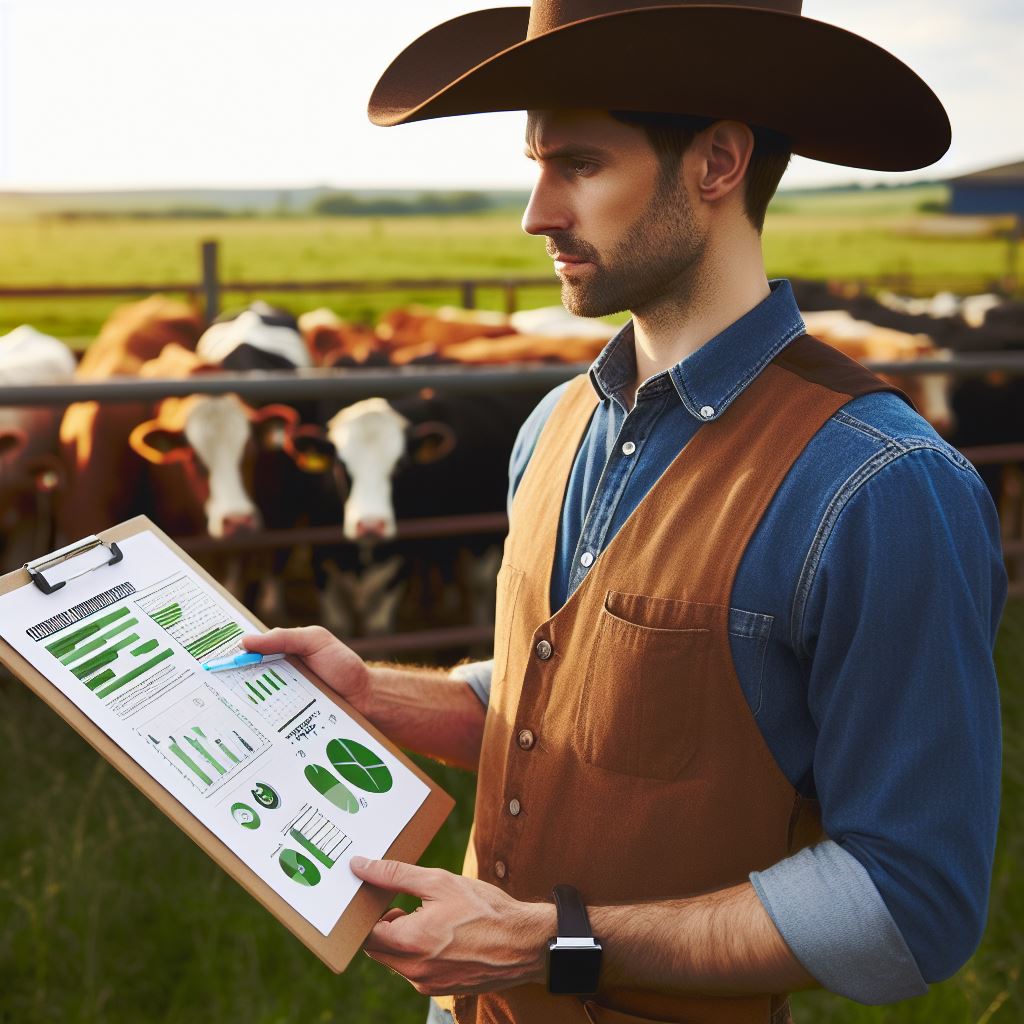Balancing Pasture Nutrition Needs
Last Updated on January 26, 2024
Introduction
Balancing pasture nutrition needs is crucial for ensuring optimal health and productivity for livestock.
Proper nutrition is key to maximizing their growth, reproduction, and overall well-being.
Importance of Balancing Pasture Nutrition Needs for Livestock
Balancing pasture nutrition needs is vital because adequate nutrition directly impacts the animals’ ability to thrive.
It ensures the right balance of proteins, carbohydrates, vitamins, and minerals, which are essential for their growth and development.
Brief Overview of Key Points to be Discussed
- Nutritional Requirements: We will explore the specific nutritional needs of different livestock species and how they vary.
- Forage Quality: The quality of the pasture directly affects the nutritional value provided to the animals.
- Grazing Management: Proper grazing management strategies can help optimize nutrient intake and prevent overgrazing.
- Supplementing Nutrients: Sometimes, pasture alone may not provide all the necessary nutrients, so we will discuss the importance of supplements.
- Monitoring and Adjusting: Regular monitoring of animal health and pasture conditions is crucial to ensure balanced nutrition.
- Benefits of Balanced Nutrition: We will examine the positive effects of providing optimal nutrition on livestock performance and overall profitability.
By understanding the importance of balancing pasture nutrition needs, livestock owners can improve the health and productivity of their animals.
Through proper management and supplementation, they can ensure that their livestock receive all the vital nutrients needed for optimal growth and well-being.
Stay tuned to learn more about each key point and how to implement effective strategies for maintaining balanced pasture nutrition.
Understanding pasture nutrition needs
In order to balance pasture nutrition needs, it is important to understand the requirements of different livestock species.
Various factors can influence pasture nutrition needs, and it is crucial to consider the definition and significance of pasture nutrition.
- Pasture nutrition refers to the availability of nutrients in the grass or forage consumed by livestock.
- It is essential for the growth, development, and overall health of animals.
- Proper pasture nutrition ensures adequate protein, energy, vitamins, and minerals in the animal’s diet.
Definition and significance of pasture nutrition
- Pasture nutrition is the composition and quality of the forage that animals graze on.
- It directly affects the productivity, reproduction, and overall well-being of livestock.
- Providing balanced nutrition through pasture can reduce the need for costly supplements or concentrates.
Nutritional requirements for different livestock species
- Cattle require a diet with good energy levels, high-quality protein, and essential minerals such as calcium and phosphorus.
- Sheep and goats need diets rich in fiber, proteins, and minerals like copper and selenium.
- Horses rely on pasture for roughage, but they also need protein, energy, vitamins, and minerals.
Factors influencing pasture nutrition needs
- Soil fertility: Adequate levels of nutrients in the soil are necessary to support the growth of nutritious pasture.
- Forage species: Different grasses and legumes vary in their nutritional composition and availability.
- Climate and season: Temperature, rainfall, and seasonal variations influence the quantity and quality of pasture.
- Grazing management: Overgrazing or underutilization can affect the nutrition content and regrowth of the pasture.
- Animal age and production stage: Young, lactating, or pregnant animals have different nutritional requirements.
To meet pasture nutrition needs, it is important to assess the quality of the forage and provide supplementation if necessary.
Regular pasture analysis can help identify nutrient deficiencies and balance the diet accordingly.
Strategies for balancing pasture nutrition needs
- Rotational grazing: Moving livestock regularly to different paddocks allows for pasture recovery and improves nutrient availability.
- Soil testing and amendment: Identifying nutrient deficiencies and adjusting soil fertility can enhance pasture growth and nutrition.
- Forage testing: Analyzing forage samples can determine nutrient content, helping in formulating appropriate supplements.
- Strategic feeding: Providing supplements or concentrates based on the nutritional needs of animals can ensure optimal nutrition.
- Monitoring and adjusting: Regularly evaluating animal performance and adjusting the diet accordingly is crucial for maintaining pasture nutrition.
By understanding the importance of pasture nutrition and considering the specific requirements of different livestock species, farmers can ensure their animals receive balanced diets for optimal growth, reproduction, and overall health.
Implementing effective pasture management practices and regular monitoring can contribute to the success and sustainability of livestock operations.
Read: Egg Production: Boosting Quality & Quantity
Assessing Pasture Quality
To ensure optimal nutrition for your livestock, it is crucial to assess the quality of your pasture.
By understanding its nutritional content, you can make informed decisions to balance your animal’s diet.
Here are some effective methods for evaluating pasture quality:
Conducting Soil Tests for Nutrient Analysis
Soil tests provide valuable insights into the nutrient composition of your pasture.
Collect soil samples from different areas and depths to get an accurate representation.
Submit these samples to a reputable laboratory for comprehensive nutrient analysis.
The results will help you understand which elements are lacking or in excess and plan your management strategies accordingly.
Evaluating Forage Species and its Nutritional Content
Different forage species have varying nutritional values.
Identify the types of plants present in your pasture and their nutritional content.
Refer to reliable resources or consult with agricultural extension services to obtain accurate information.
This knowledge will allow you to determine which forage species are best suited for your livestock’s dietary needs.
Identifying Signs of Deficiency or Surplus in Pasture
Regular observation of your pasture can help you identify signs of nutrient deficiency or surplus.
Watch out for stunted plant growth, yellowing leaves, or unusual appearances.
These visual cues can indicate nutrient imbalances in your pasture.
Additionally, monitor your animals’ health and performance as poor conditions may be indicative of inadequate nutrition provided by the pasture.
Signs of Deficiency
- Skinny or emaciated livestock
- Decreased milk production in dairy cows
- Reduced weight gain in growing animals
- Decreased reproductive performance
Signs of Surplus
- Abnormal weight gain or obesity in livestock
- Altered milk composition in dairy cows
- Unbalanced nutrient ratios leading to mineral imbalances
Addressing Nutrient Imbalances
Once you have identified nutrient imbalances in your pasture, take appropriate measures to rectify them.
Here are some strategies:
- Adjusting Grazing Management Practices: Implement rotational grazing or consider dividing your pasture into paddocks. This practice promotes even utilization of forage and prevents selective grazing, which could lead to nutrient deficiencies or surpluses.
- Implementing Strategic Supplementation: Based on your soil test results, consult with a nutritionist or veterinarian to develop a suitable supplementation plan. This may include providing mineral blocks, forage additives, or balanced feed rations to compensate for specific nutrient deficiencies.
- Implementing Lime or Fertilizer Applications: If nutrient deficiencies are detected, apply lime or fertilizers to improve soil fertility. However, ensure you follow recommended application rates to avoid excessive nutrient levels that can harm the environment.
- Reseeding or Establishing New Forage Species: Consider reseeding your pasture with appropriate forage species that are nutritionally balanced for your livestock. Ensure you select species suited to your soil type and climate to optimize growth and nutritional value.
By regularly assessing the quality of your pasture, you can provide your livestock with balanced and nutritious diets.
This proactive approach will enhance their health, productivity, and overall well-being, leading to a successful farming operation.
Read: Winter Care Tips for Your Poultry Flock

Managing Pasture Nutrition
Pasture nutrition is crucial for the overall health and productivity of livestock.
By carefully managing the nutrient content in pasture, farmers can ensure that their animals have access to the right balance of nutrients to meet their needs.
Rotational Grazing Techniques
One effective technique for managing pasture nutrition is rotational grazing.
This involves dividing the pasture into smaller paddocks and rotating the livestock between them.
This allows the grass to recover and regrow, ensuring a constant source of fresh, nutritious forage.
Rotational grazing also helps to maximize the utilization of pasture.
By moving the livestock to a fresh paddock when the grass is at an optimal height, the animals can consume the most nutritious parts of the forage while preventing overgrazing.
Proper Stocking Rates to Prevent Overgrazing
Another important factor in managing pasture nutrition is maintaining proper stocking rates.
Overgrazing occurs when there are more animals on a pasture than it can support, resulting in the depletion of forage and reduced nutrient availability.
By carefully monitoring the number of animals grazing on a pasture and adjusting the stocking rates accordingly, farmers can prevent overgrazing and ensure that the available forage is sufficient to meet the nutritional needs of the livestock.
Introducing Legumes or Forage Mixtures to Enhance Nutrition
Adding legumes or forage mixtures to the pasture can greatly enhance its nutritional value.
Legumes, such as clover or alfalfa, are rich in protein and other essential nutrients that can supplement the grass forage.
The presence of legumes in a pasture not only improves the nutrient content of the forage but also helps to naturally fix nitrogen in the soil, reducing the dependence on synthetic fertilizers.
Forage mixtures that incorporate a variety of plant species can also provide a more diverse range of nutrients.
Different plants have different nutritional profiles, and a mixture of grasses, legumes, and other forbs can offer a well-rounded diet for the livestock.
Managing pasture nutrition is essential for ensuring the health and productivity of livestock.
By implementing rotational grazing techniques, maintaining proper stocking rates, and introducing legumes or forage mixtures, farmers can achieve a balanced and nutritious pasture for their animals.
By adopting these practices, farmers can maximize the utilization of pasture, prevent overgrazing, and provide their animals with a diverse and well-rounded diet.
Ultimately, this will lead to healthier, more productive livestock and improved overall farm profitability.
Read: Effective Poultry Waste Management Strategies
Supplementing pasture nutrition
Supplementing pasture nutrition plays a crucial role in ensuring the health and productivity of grazing animals.
While pasture can provide a good source of nutrients, it may not always meet the animals’ specific requirements.
This is why identifying deficiencies and selecting appropriate supplements is essential.
To start with, it is important to understand that deficiencies can vary depending on factors such as soil quality, forage type, and animal breed.
It’s crucial to assess the nutritional content of the pasture as a first step in identifying any deficiencies.
This can be done through soil testing and forage analysis.
Once deficiencies are identified, selecting the right supplements becomes crucial.
Different supplements cater to specific nutritional needs.
For instance, if there is a lack of protein in the pasture, protein-based supplements can be a suitable option.
Likewise, if vitamins and minerals are lacking, a well-balanced mineral lick or block can be provided.
There are several available options for supplementing pasture nutrition.
These options can range from commercially available feeds and premixes to more natural alternatives, such as providing access to specific forage or planting nutrient-rich crops like legumes.
The delivery and monitoring of supplements require careful attention.
Ensuring proper delivery involves providing supplements in a way that animals can easily consume them.
This can be done through mixing supplements with their daily feed or making them accessible through mineral feeders.
Monitoring the effectiveness of the supplements is also crucial.
Regular body condition scoring and performance monitoring can help gauge whether the chosen supplements are meeting the animals’ nutritional needs.
Adjustments can be made if necessary.
Supplementing Pasture Nutrition
- Identify deficiencies through soil testing and forage analysis.
- Select suitable supplements based on deficiencies identified.
- Consider protein-based supplements for protein deficiencies.
- Provide mineral licks or blocks for vitamin and mineral deficiencies.
- Explore available options such as commercially available feeds, premixes, or specific forage.
- Plant nutrient-rich crops like legumes to supplement pasture nutrition.
Ensuring Proper Delivery and Monitoring
- Deliver supplements in a way that animals can easily consume them.
- Mix supplements with daily feed or utilize mineral feeders for accessibility.
- Monitor animals’ body condition scores and performance to assess supplement effectiveness.
- Make adjustments to supplement types or amounts if necessary to meet nutritional needs.
Basically, supplementing pasture nutrition is crucial to balancing the nutritional needs of grazing animals.
By identifying deficiencies, selecting appropriate supplements, exploring available options, and ensuring proper delivery and monitoring, animals can thrive and achieve optimal health and productivity.
Read: Integrating Livestock: Poultry with Other Farm Animals
Monitoring and adjusting
Monitoring and adjusting pasture nutrition needs is essential for maintaining healthy livestock and maximizing their performance.
Farmers and ranchers must regularly monitor the health and performance of their animals and make adjustments based on observed deficiencies or excesses.
Consulting with agricultural experts or nutritionists can provide valuable guidance in this process.
Regular monitoring of livestock health and performance
- Observe livestock regularly to assess their overall health and behavior.
- Keep track of any signs of illness, such as decreased appetite, weight loss, or abnormal behavior.
- Monitor the body condition score of individual animals to ensure they are maintaining an ideal weight.
- Regularly inspect pastures for forage quality and availability, as this directly impacts animal nutrition.
Making adjustments based on observed deficiencies or excesses
- Conduct regular forage testing to determine the nutritional content of the available pasture.
- Identify any deficiencies or excesses in key nutrients like protein, energy, minerals, and vitamins.
- Use the results from forage testing to formulate a balanced diet that meets the specific nutritional requirements of the livestock.
- Adjust the grazing strategies and/or supplement feeding programs accordingly to address any nutritional imbalances.
Consulting with agricultural experts or nutritionists for guidance
- Seek advice from agricultural experts or nutritionists who have specialized knowledge in livestock nutrition.
- Share the results of forage testing and discuss any observed deficiencies or excesses with the experts.
- Receive guidance on formulating a balanced diet that addresses the specific nutritional needs of the livestock.
- Discuss any concerns or challenges related to pasture nutrition and explore potential solutions.
By monitoring and adjusting pasture nutrition needs, farmers and ranchers can ensure their livestock receive optimal nutrition, which directly impacts their overall health and performance.
This proactive approach helps prevent nutritional deficiencies or excesses, which could lead to reduced productivity, increased disease susceptibility, and poor reproductive performance.
Regular monitoring enables farmers and ranchers to identify patterns or trends in the livestock’s health and performance, allowing for timely adjustments.
For example, if a group of animals consistently shows signs of mineral deficiency, the farmer can adjust the mineral supplementation accordingly or consider switching to a different mineral source.
Consulting with agricultural experts or nutritionists adds an extra layer of expertise and ensures that farmers and ranchers receive the most up-to-date information and recommendations.
These professionals can provide valuable insights into common nutritional imbalances or challenges specific to the region or livestock type.
They can also help farmers and ranchers navigate through various options, such as selecting the right type of supplementation or adjusting grazing strategies to optimize pasture utilization.
Essentially, monitoring and adjusting pasture nutrition needs is crucial for maintaining healthy livestock and maximizing their performance.
Regular monitoring, making adjustments based on observed deficiencies or excesses, and consulting with agricultural experts or nutritionists all play essential roles in achieving this goal.
By prioritizing pasture nutrition, farmers and ranchers can enhance the overall well-being and productivity of their livestock operations.
Conclusion
Balancing pasture nutrition needs is critical for the health and productivity of livestock.
In this blog section, we discussed the importance of providing proper nutrition to grazing animals.
By meeting their nutritional requirements, we can ensure optimal growth, performance, and overall well-being.
Key takeaways from this discussion include the significance of understanding the nutritional composition of pastures.
Additionally, we highlighted the importance of balancing the essential nutrients such as protein, energy, vitamins, and minerals.
Well-managed pastures and a balanced diet can help prevent health issues and maximize livestock productivity.
It’s crucial to regularly assess the nutritional needs of the animals to make suitable adjustments.
Implementing strategies like rotational grazing and supplementing with quality feed can support optimal pasture nutrition.
We encourage farmers and ranchers to collaborate with nutrition experts and veterinarians to develop customized nutrition plans.
By doing so, they can ensure healthy and productive livestock, contributing to the success of their farming operations.
Remember, a well-fed animal is a happy and profitable one.


